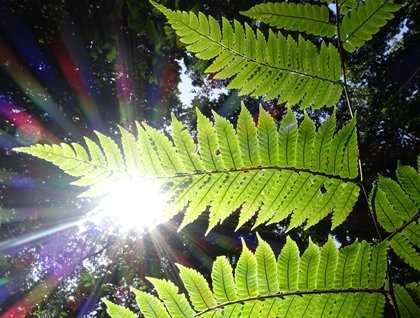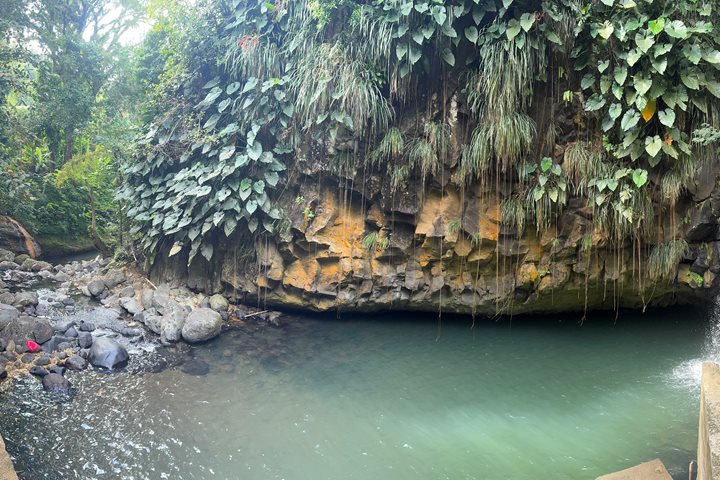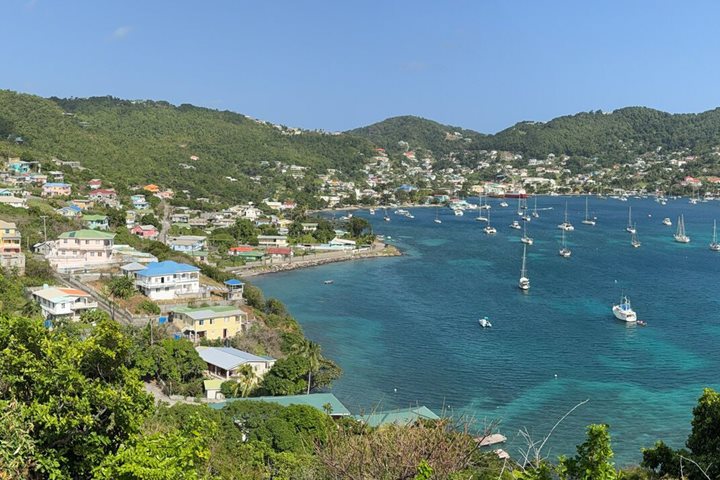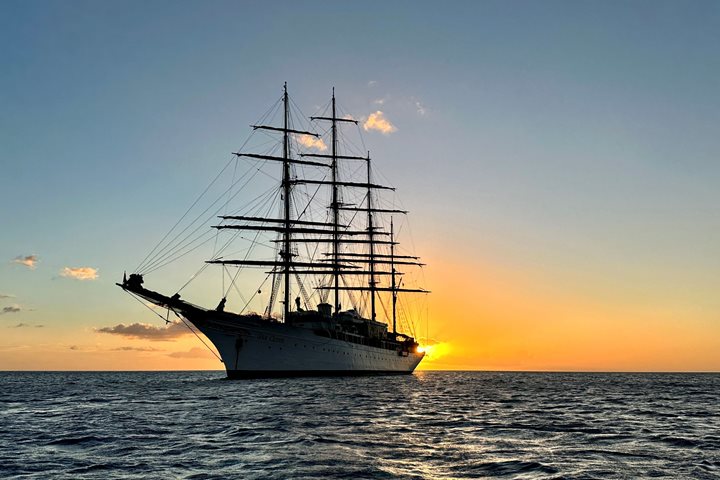We motored into Prince Rupert Bay at 6:50 a.m. and docked in 36 knot winds without dock handlers at 7:15. A gracious fisherman helped with the lines. Dominica is not very well visited and the Dominican’s are very laid back. Perhaps the dockworkers will be there next time!
Dominica is the youngest of the Antilles with active volcanoes and the sea off the southwest at Scott’s Head is more than 6000 feet. Dominica is still growing.
The lush green of Dominica spread its canopy ever where I looked. I could see our ultimate morning’s journey Morn Diabolotin (Waitukubuli in the Kalinago language) from starboard side of Sea Cloud rising 4,800 feet above the sea. We drove for 40 minutes through this lush green paradise, passing plantings of mangoes, papayas, coconuts, bananas, taro (dasheen in the local dialect), sweet potatoes, yams, coffee, and cacao. Poinsettias grew along the road as trees 20 feet tall; cotons of all colors and sizes, antherium and bird of paradise grew everywhere. During our walk of 1½ miles through the rain forest we found trees with buttressing of over 100 feet in diameter. The names of the trees in the local patois are an education in themselves. I will remind you of just one—the infamous “Bwa KaKa” whose wood is used for shingle roofing. The Kriol spelling of the French “bois” for wood is “bwa” and “kaka”—which needs no definition—identifies the rather noxious smell of the tree on cutting. Epiphytes grew in profusion, as did tree ferns. We managed to see some of the rare parrots in flight with their blue, green, and yellow plumage.
After a scrumptious lunch that included a freshly caught and largest fresh mahi mahi (70 pounds) I have ever seen, Tom Heffernan gave an introduction to the 18th century English Fort Shirley and led us on an hour-long walk to the fort and an exploration of the grounds. The fort was begun in 1774 and completed by 1778 and built entirely by local slaves. The fort is massive and spreads across most of the 200 acres of the Cabrits’ headland. Only a small part of the original has been reclaimed from the jungle. Strangler vines and jungle cover the rest. The fort never saw action and existed principally as a deterrent. Designed by the 18th century American architect Peter Harrison to protect the Royal Navy at anchor in Prince Rupert Bay. The fort’s canons could sweep the entire area in front of the town of Portsmouth. There was another battery across the Bay and the two batteries made the bay inviolate. At its zenith the fort had 700 enlisted men and a contingent of the 8th West Indian Regiment made up of slaves. The French forces under Admiral DeBouille took Dominica in September of 1778 only to loose it again in the Treaty of Paris of 1783. The Fort was abandoned in 1852 and lay derelict and in ruin covered by strangler figs and the jungle until a good friend of mine, Dr. Lennox Honeychurch, a native of Dominica, undertook restoration beginning in 1982. Lennox is still working on the restoration and has accomplished miracles, as we all can now attest.
While we were standing at the fort’s battery looking across Prince Rupert Bay, a microburst of wind roared through and capsized a sailing vessel in the bay. I radioed the ship immediately. A man was thrown overboard and the ship was floating on its side. Within a few minutes a powerboat made it to the sinking vessel recovered the man and was able to right the boat.
After our visit to the fort, some of the hardiest of us braved the winds and the waves and went snorkeling. The wind was whipping whitecaps almost 2 feet high and it was an exhilarating experience just being in the beautiful sea. The wind was still gusting at 5 p.m. as we were about to leave. As we have no bow thrusters, getting off the pier with a 350-foot sailing ship requires a very skilled captain and crew, all of which we have. Our captain crew did it effortlessly and we sailed into the lee of Dominica and less wind.
Dinner was under the stars on the lido deck. Off to bed after a full day.









